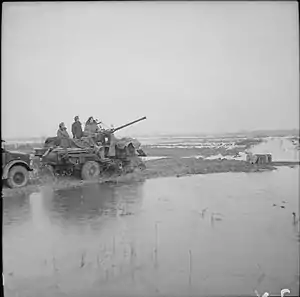Bedford MW
The Bedford MW was a general service truck used by the British Armed Forces during the Second World War.
| Bedford MW | |
|---|---|
 Bedford MWD 15cwt truck with Rhodesian troops of the 60th King's Royal Rifles, Western Desert, 1942. | |
| Type | General service truck |
| Place of origin | United Kingdom |
| Service history | |
| In service | 1939–late 1950s |
| Used by | British Army, Royal Air Force & Royal Navy |
| Wars | Second World War |
| Production history | |
| Designer | Bedford Vehicles |
| Designed | 1937 |
| Manufacturer | Bedford Vehicles |
| No. built | More than 66,000 |
| Specifications | |
| Mass | 2.1 long tons (2.1 t) |
| Length | 14 ft 4 in (4.37 m) |
| Width | 6 ft 6 in (1.98 m) |
| Height | 7 ft 6 in (2.29 m) |
| Crew | 2 |
| Engine | Six-cylinder inline Bedford OHV 210 cu in (3.5 L) petrol 72 bhp (54 kW) at 3,000rpm |
| Payload capacity | 15 long cwt (760 kg) |
| Drive | Wheeled 4x2 |
| Transmission | 4F1R |
| Suspension | Live axles on semi-elliptical multi leaf springs |
| Maximum speed | 40 mph (64 km/h) |
| References | Chris Bishop[1] & Pat Ware[2] |
Design
The Bedford MW was a 15 cwt (760 kg) 4x2 truck, powered by a Bedford 72 bhp (54 kW) six-cylinder inline 210 cu in (3.5 L) petrol engine through a four speed transmission.[1][2]
Despite lacking four wheel drive and so being unsuited for off road use, the MW's powerful engine, short wheel base, low centre of gravity and relatively light weight gave it excellent acceleration and almost sports car like handling.[2]
The early MWs were open cabbed with a folding windscreen and a collapsible canvas tilt, from 1943 an enclosed cab with doors and perspex side screens was added, retaining the canvas top. The vehicle had a distinctive wide bonnet, necessitated by the need to accommodate a special extra large air filter that was never fitted to production vehicles.[1][2]
History
In 1935 the War Office issued specifications for a new 15 cwt 4x2 military truck for service with the British Army, inviting manufacturers to submit designs to take part in annual comparative trials in north Wales, one entrant was a modification of a Bedford Vehicles 2 ton rear wheel drive lorry. Following these trials Bedford fitted a larger radiator and larger tyres, the trials were repeated in 1936 after which Bedford modified the chassis to increase ground clearance and installed a new engine cooling system. For the 1937 trials a new special Bedford WD-1 prototype was produced with a 15 cwt payload, it performed admirably and in 1938 the eventual 72 bhp engine was installed.[1][2]
Between 1939 and 1945 Bedford produced over 66,000 MWs, the vehicles remained in British service until the late 1950s.[1][2]
Use
The MW was intended mainly to be a workhorse for the British Army's infantry battalions, but throughout the war it was adapted to a number of roles and was eventually also used by the Royal Air Force, Royal Navy, other government departments and some overseas customers.[1][2]
Variants

.jpg.webp)


The Bedford MW was built in multiple variants including:[2]
- Bedford MWD cargo truck with General Service body
- Bedford MWC water tank truck
- Bedford MWT anti-aircraft gun tractor
- Bedford MWG QF 2 pounder or 20mm Oerlikon portee
- Bedford MWR radio truck
- Bedford MWV RAF signals van
Gallery
 Water-carrying trucks of 12 Corps filling up at a water point, 12 July 1944.
Water-carrying trucks of 12 Corps filling up at a water point, 12 July 1944. Bofors gun of 89th Light Anti-Aircraft Regiment at Elst in Holland, 15 December 1944.
Bofors gun of 89th Light Anti-Aircraft Regiment at Elst in Holland, 15 December 1944. Bedford MWD trucks in the Netherlands
Bedford MWD trucks in the Netherlands 1st Royal Irish Fusiliers with French 25mm 34 SA anti-tank gun on the back of a Bedford MWD, January 1940.
1st Royal Irish Fusiliers with French 25mm 34 SA anti-tank gun on the back of a Bedford MWD, January 1940.
References
| Wikimedia Commons has media related to Bedford MW. |
- Chris Bishop (ed), The encyclopedia of weapons of World War II, London: Metro Books, 1998, ISBN 1-58663-762-2.
- Pat Ware, A complete directory of military vehicles, Wigston: Anness Publishing Ltd, 2012.